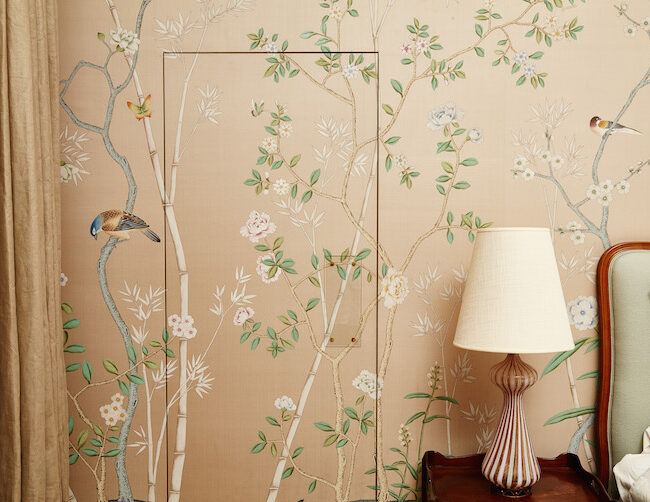So, what is a jib door?
A jib door has one purpose, and that’s to blend in. Here’s more on the ‘invisible’ door…
The job of a jib door is to sit flush (with the same elevation as the wall) and be ‘invisible’. When done right, they look incredible. But you need to get every stage of the process correct to nail the end result. The way we approach jib doors from an installation point of view firstly depends on what wallcovering has been specified. If it is a bespoke wallcovering, say a Fromental or De Gournay, then there is very little room for error.

Is it ready for installation?
Firstly, you want to make sure the measurements of the jib door are really accurate. Then, once you know what the wallcovering is, find out how thick and mailable it is (how it returns over the external corners). Once you know that, you can advise the site manager about the gap you think should be left.
When we refer to the ‘gap’ we are talking about the space between the door and the frame, which will allow it to open and close successfully without the wallcovering catching. If you were installing a classic British pulp for example, which is approximately 1mm thick, we would advise that we need a gap of 3-4mm. The gap must be no less than 3mm at any stage of the opening and closing arch of the door. You do not want the wallpaper catching either on the hinge side, on the opposite side or at the top of the door at any stages of the opening and closing because it will scuff and it will look really old really quickly. The biggest mistake would be to cut the gap too tight. It’s actually better to have the gap wider than needed because it looks really bad when the wallcovering starts to catch. This information needs to be ironed out and confirmed well before the installation starts so the site know they may need to change the gap, hinges or even the wallpaper.
Things to consider…
- Balancing the door – what goes on the front should go on the back, otherwise there is a chance of warping.
- Every door is different and needs to be treated uniquely. What is the material of the door? Is it porous or non-porous? Does the door need priming?
- Can the door be wrapped? If it can’t, which means you have to finish on the edge, the side of the door may need to be painted another colour or even black to look like a shadow.
- Does the door need to come off? This may result in requiring extra time and man power, which will not only impact the deadline but the total cost too.
- Does the wallcovering feature a pattern? If it does, this will make the job more complex and time-consuming.

We have shared two examples of our jib doors, both featuring De Gournay wallcoverings. The above image was from a project we worked on with Interior Designer Charlotte Lane Fox. In the dining room, Charlotte chose the graceful ‘Wisteria’ design from de Gournay’s Japanese & Korean collection. The wallpaper had to be installed seamlessly across an ‘invisible’ jib door, a feat that our master craftsmen executed with aplomb. When dealing with practical requirements like this, a respect for and deep knowledge of one’s materials is crucial.
Scroll down for what Charlotte had to say about working with Wells Interiors. For more information on this project in South Kensington, click HERE
TESTIMONIAL…
“I have used Wells Interiors for projects many times and have no concerns or fears when working with them. They provide a quality, efficient and professional service with lovely on-site paperhangers achieving perfect end results and happy clients. To anyone who is unsure whether to choose Wells for their project I cannot recommend them more highly and have had nothing but a happy working relationship with them over the years,” Charlotte Lane Fox.





